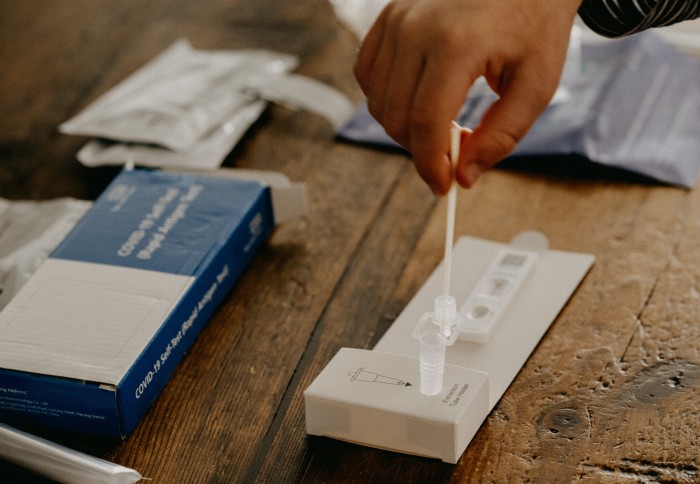Coronavirus infections remain high while Omicron ‘stealth variant’ rises - REACT

Coronavirus infections have continued to decline in England but remain at a high level, according to new surveillance data.
Findings from the REACT coronavirus monitoring programme, based on almost 95,000 swab tests taken between 8 February and 1 March, show that around 1 in 35 was infected during this period, or 2.88% of people. This is the second highest the study has recorded since it began testing in May 2020, but represents a drop from previous findings when 1 in 23 had the virus in January, or 4.41%.
The Imperial team read the genetic codes of the virus from 1,195 positive samples, finding that all but one were the Omicron variant or an offshoot (sub-variant). The remaining was Delta.
"A high number of infections will lead to more people becoming ill, so it’s important that people continue to follow public health guidance." Prof Paul Elliott School of Public Health, Imperial
As of 21 February it was estimated that almost half (47.2%) were the BA.2 ‘stealth variant’ (named due to the absence of certain genetic changes that can distinguish this variant easily from others), which is a variant under investigation. This is a substantial increase from the study’s previous findings when 0.8% were BA.2 in January, and suggests that this sub-variant spreads more easily than other circulating variants. The highest rates of BA.2 were found in London.
There was wide variation in infection rates by age, with infection prevalence decreasing with age. Nearly three times as many were testing positive in the youngest age group (aged 5-11, 4.69%) compared with the oldest (aged 75+, 1.68%). However, infections were found to be falling in children and younger adults under the age of 54, while they were flat or possibly rising in those aged 55 and above.
There was also variation across the country, with higher rates in the South.
Professor Paul Elliott, director of the REACT programme from Imperial’s School of Public Health, said: “It’s encouraging that infections have been falling across England, but they are still very high and the possibility that they are rising in older adults may be cause for concern.
“The good news is that this is a highly vaccinated group, however a high number of infections will lead to more people becoming ill, so it’s important that people continue to follow public health guidance to avoid fuelling further spread of the virus.”
These findings from the REal-time Assessment of Community Transmission (REACT-1) programme, led by Imperial College London with Ipsos MORI and commissioned by the Department of Health and Social Care, are available here in a pre-print report and are being submitted for peer-review. Data are continually reported to the Government to inform decision-making.
Higher infections in the South
For this latest round of the REACT study, 94,950 people swabbed themselves at home and their samples were analysed by PCR testing. 2,731 of these were positive, giving an overall weighted prevalence of 2.88%. Weighting is where the researchers make adjustments to their calculations to ensure the sample reflects England’s population.
The scientists estimate that the reproduction number (R) was slightly below 1, at 0.94. This means that 10 infected people would pass the virus onto around nine others on average, indicating a slightly shrinking epidemic.
Prevalence was high in all regions of the country, with the highest rate of infections found in the South East (3.33%) and London (3.20%). The lowest was found in the North East at 2.33%. Since the previous round, infections fell in all parts of the country except the South East and South West, which rose slightly.
Of the ten lower-tier local authority areas with the highest prevalence in the country, six were in London while the rest were in the South West.
"The pandemic is not over"
"Vaccination remains the best way to protect us all from severe disease and hospitalisation." Dr Jenny Harries UK Health Security Agency
Dr Jenny Harries, Chief Executive of the UK Health Security Agency, said: “These data confirm that cases have declined substantially following the peak of the Omicron wave.
“However, the increasing presence of the BA.2 sub-lineage of Omicron and the recent slight increase in infections in those over 55 show that the pandemic is not over and that we can expect to see COVID circulating at high levels.
“Vaccination remains the best way to protect us all from severe disease and hospitalisation due to COVID-19 infection. We urge you to come forward for your primary or booster doses straight away if you have not already done so.”
Health and Social Care Secretary Sajid Javid said: “It is reassuring to see that COVID-19 cases have continued to fall as we learn to live with the virus and regain our freedoms.
“We must continue to protect each other where necessary. Vaccines remain our best line of defence against the virus. If you haven’t already, please Get Boosted Now.”
Kelly Beaver, CEO at Ipsos MORI, said: “It is very positive to see prevalence falling month on month, but vigilance remains critical, particularly with the concern that we may be seeing a small uptick in cases among the elderly.
“REACT has been a vital epidemiological tool over the last two years and we would like to thank the over 3 million people who have taken part across the various studies, for contributing to this incredibly important research.”
Article text (excluding photos or graphics) © Imperial College London.
Photos and graphics subject to third party copyright used with permission or © Imperial College London.
Reporter
Justine Alford
Institute of Global Health Innovation